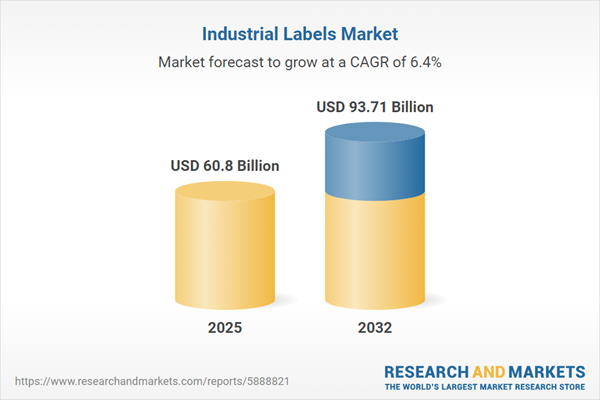Speak directly to the analyst to clarify any post sales queries you may have.
The industrial labels market is experiencing significant evolution as organizations address stricter compliance standards, streamlined supply chains, and the necessity for distinctive brand presence. As stakeholder requirements intensify, senior decision-makers prioritize solutions that efficiently manage regulatory complexity and support long-term growth objectives.
Market Snapshot: Current Size and Growth Trajectory
The global industrial labels market achieved a value of USD 57.07 billion in 2024 and is expected to reach USD 60.80 billion by 2025. Over the forecast period through 2032, the sector anticipates a compound annual growth rate (CAGR) of 6.39%, leading to an estimated size of USD 93.71 billion. This upward trend is shaped by wider implementation of advanced technology, such as digital and smart labeling for better supply chain visibility, and a stronger commitment to compliance across varying regulatory landscapes worldwide. Investment in robust label systems is now regarded as essential for operational continuity in complex, interconnected supply chains.
Scope & Segmentation: Industrial Labels Market Opportunities
- Label Formats: Options including pressure sensitive, shrink sleeve, in-mold, wrap around, and transfer labels are tailored for sectors like manufacturing, healthcare, and pharmaceuticals, delivering industry-specific durability and branding advantages.
- Printing Technologies: Digital, flexographic, thermal transfer, rotary, and rotogravure printing each provide scalable and customizable solutions, enabling brand consistency, differentiation, and adaptation to market shifts in competitive sectors.
- Materials and Adhesive Types: Permanent and removable substrates such as PE, PET, PP, OPS, PETG, and PVC ensure reliability under diverse conditions. Hot melt, solvent-based, and water-based adhesives address pressing sustainability and compliance concerns, supporting improved recyclability and safe usage in various regions.
- Container & Application Surfaces: Engineered for glass, metal, and plastic surfaces, industrial labels meet the needs of industries such as automotive, food and beverage, and medical devices. These categories demand high performance under regulatory scrutiny and logistical complexity.
- Geographic Regions: The market covers the Americas, Europe, Middle East & Africa, and Asia-Pacific, each with distinctive regulatory environments. Key markets like the United States, China, Germany, and India present varying compliance requirements and consumer expectations, influencing both technology adoption and sourcing.
- Industry Players: Leading companies including Avery Dennison, 3M Company, UPM Raflatac, CCL Industries, LINTEC, Multi-Color Corporation, and FLEXcon consistently adapt offerings and advance next-generation labeling to support shifting compliance protocols.
Key Takeaways for Senior Decision-Makers
- Digital and smart labeling innovations are now central to real-time supply chain monitoring, empowering teams to anticipate and adapt to operational disruptions quickly.
- The transition to environmentally responsible materials and adhesives is now a clear driver in supplier negotiations and fosters stronger compliance with sustainability directives.
- Product customization and adaptable production are critical for adjusting inventory, meeting evolving customer requirements, and preventing process bottlenecks.
- Tailoring technology adoption and sourcing strategies by region boosts resilience and competitiveness amid varying local compliance demands.
- Industry consolidation encourages deployment of data-rich label solutions, streamlining communication across supply chain partners and enhancing alignment with regulatory requirements.
Tariff Impact and Navigating Input Cost Pressures
Recent tariffs on raw materials within the United States market have led suppliers to reassess sourcing strategies and logistics workflows. Companies are now designing labels with a greater emphasis on localization, forming new partnerships with domestic and alternative suppliers, and engaging agile vendors. These measures help reduce volatility in input costs and strengthen overall supply chain reliability, allowing organizations to maintain operational consistency in a shifting economic climate.
Methodology & Data Sources
This market overview is based on interviews with manufacturing leaders and supply chain professionals, comprehensive regulatory reviews, authoritative industry white papers, and unique quantitative research. All insights are backed by practical adhesion and recyclability testing, ensuring relevance to operational demands and environmental standards.
Why This Report Matters
- Provides actionable compliance strategies to mitigate operational risk and streamline communication across diverse jurisdictions.
- Presents targeted segmentation and regional insights to help organizations align resources and shape sustainable expansion plans.
- Enables senior leaders to proactively prepare for, and adapt to, dynamic regulatory expectations and supply chain conditions.
Conclusion
Comprehensive, well-designed industrial labeling is fundamental to strong brand management and efficient global operations. This report equips executives with the market insight required to lead confidently and respond to emerging operational challenges across regions.
Additional Product Information:
- Purchase of this report includes 1 year online access with quarterly updates.
- This report can be updated on request. Please contact our Customer Experience team using the Ask a Question widget on our website.
Table of Contents
3. Executive Summary
4. Market Overview
7. Cumulative Impact of Artificial Intelligence 2025
Companies Mentioned
The companies profiled in this Industrial Labels market report include:- Avery Dennison Corporation
- 3M Company
- CCL Industries Inc.
- Multi-Color Corporation
- UPM Raflatac Oy
- Brady Corporation
- Lintec Corporation
- SATO Holdings Corporation
- FLEXcon Company, Inc.
- Schreiner Group GmbH & Co. KG
Table Information
| Report Attribute | Details |
|---|---|
| No. of Pages | 189 |
| Published | November 2025 |
| Forecast Period | 2025 - 2032 |
| Estimated Market Value ( USD | $ 60.8 Billion |
| Forecasted Market Value ( USD | $ 93.71 Billion |
| Compound Annual Growth Rate | 6.3% |
| Regions Covered | Global |
| No. of Companies Mentioned | 11 |









